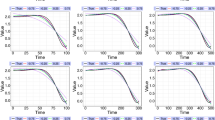Abstract
The efficiency of OLSE relative to GLSE and COTE is studied in the case in which regressors are splines used to explain seasonal influences. It is thereby shown that efficiency measured as the ratio of total or generalized variances is independent of the actual design of splines. Furthermore, for positive autocorrelation, COTE is always worse than OLSE.
Similar content being viewed by others
References
Busse, R., Jeske, R. and Krämer, W. (1994). Efficiency of least squares-estimation of polynomial trend when residuals are autocorrelated. Economics Letters, 45, 267–271.
Chipman, J.S., Kadiyala, K.R., Madansky, A. and Pratt, J.W. (1968). Efficiency of the sample mean when residuals follow a first-order stationary Markov process. Journal of the American Statistical Association, 63, 1237–1246.
Corrigendum (1969). ibid 64, 1700.
Chipman, J.S. (1979). Efficiency of least-squares estimation of linear trend when residuals are autocorrelated. Econometrica, 47, 115–128.
Cochrane, D. and Orcutt, G.H. (1949). Application of least squares regression to relationships containing autocorrelated error terms. Journal of the American Statistical Association, 44, 32–61.
Doran, H.E. (1981). Omission of an observation from a regression analysis. Journal of Econometrics, 16, 367–374.
Harvey, A.C. (1981). The Econometric Analysis of Time Series. Philip Allan, Oxford.
Hoque, A. (1989). The efficiency of the Cochrane-Orcutt procedure. Australian Journal of Statistics, 31, 385–392.
Jeske, R., Bütefisch, T. and Song, S.H. (1997). The efficiency of the sample mean in linear regression model when errors follow a first-order moving average process. Economics Letters, 52, 235–240
Kadiyala, K.R. (1968). A transformation used to circumvent the problem of autocorrelation. Econometrica, 36, 93–96.
King, M.L. (1984). A new test for fourth-order autoregessive disturbances. Journal of Econometrics, 24, 269–277.
Krämer, W. (1982). Note on estimating linear trend when residuals are autocorrelated. Econometrica, 50, 1065–1067.
Krämer, W. (1984). High correlation among errors and the efficiency of ordinary least squares in linear models. Statistical Papers, 25, 135–142.
Maeshiro, A. (1976). Autoregressive transformation, trended independent variables and autocorrelated disturbance terms. Review of Economics and Statistics, 58, 497–500.
Maeshiro, A. (1979). On the retention of the first observations in serial correlation adjustment of regression models. International Economic Review, 20, 259–265.
Maeshiro, A. (1980). Autocorrelation and trended explanatory variables: A reply. Review of Economics and Statistics, 62, 487–489.
Oxley, L.T. and Robert, C.T. (1982). Pitfalls in the application of the Cochrane Orcutt technique. Oxford Bulletin of Econometrics and Statistics, 14, 227–240.
Park, R.E. and Mitchell, B.M. (1980). Estimating the autocorrelated error model with trended data. Journal of Econometrics, 13, 185–201.
Poirier, D.J. (1978). The effect of the first observation in regression models with first-order autoregressive disturbances. Applied Statistics, 27, 67–68.
Prais, S.J. and Winsten, C.B. (1954). Trend estimators and serial correlation. Cowles Commission Discussion Paper, 383, University of Chicago.
Puterman, M.L. (1988). Leverage and influence in autocorrelated regression models. Applied Statistics, 37, 76–86.
Spitzer, J.J. (1979). Small sample properties of nonlinear least squares and maximum likelihood estimators in the context of autocorrelated disturbances. Journal of the American Statistical Association, 36, 93–96.
Taylor, W.E. (1981). On the efficiency of the Cochrane-Orcutt Estimator. Journal of Econometrics, 17, 67–82.
Author information
Authors and Affiliations
Rights and permissions
About this article
Cite this article
Jeske, R., Song, S.H. Relative efficiency of OLSE and COTE for seasonal autoregressive disturbances. Statistical Papers 44, 421–432 (2003). https://doi.org/10.1007/s00362-003-0164-9
Received:
Revised:
Issue Date:
DOI: https://doi.org/10.1007/s00362-003-0164-9




